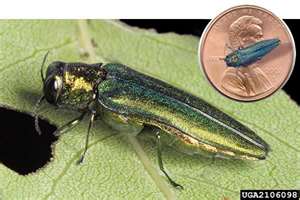Emerald Ash Borer

EAB Adult, David Cappaert, Bugwood.org
The federal quarantine for ash wood, products, and emerald ash borer life stages has been removed. The Virginia Department of Agriculture and Consumer Services has up to date information on quarantines.
To prevent the introduction of other invasive species, firewood and other untreated wood should not be moved far distances to reduce the risk of spreading tree pests. Generally, it is recommended to move untreated wood no farther than 50 miles from its source, ideally under 10 miles is best.
Emerald Ash Borers (EAB) are originally from eastern Russia, northern China, Japan, and Korea. The original infestations were found in 2002 near Detroit, Michigan, and traveled to Maryland and northern Virginia from Michigan in infested nursery trees. Their populations are increasing rapidly because they have few effective predators here. They have already killed tens of millions of trees in North America, and show no signs of stopping. By the end of 2011 they have already killed more trees than Dutch Elm Disease.
EAB attacks all species of Ash (Fraxinus spp.), and causes around 99% mortality outside of EAB's native range. EAB has also been found to affect White Fringe Trees, Chionanthus virginicus, a species native to the eastern U.S. The most damaging stage of their life cycle is the larval stage, when they tunnel around under the bark of the tree, affecting the tree's ability to transport nutrients and water. Trunks and branches with a diameter of approximately 1 inch or greater can be affected. After consuming the wood EAB pupates, later emerging as adults through distinctive 1/8 inch D shaped exit holes. The adults disperse, mate, and lay eggs on the bark of ash trees, starting the process all over again.
EAB in Prince William County
EAB was first found in Prince William County in 2010. Subsequent years of trapping (using large sticky purple traps) indicated that Emerald Ash Borer is present across the county - trapping is no longer being conducted by our branch. Most mature ash trees in the county have died. Remaining ash usually show symptoms of EAB; epicormic branching (water sprouts), canopy die back, woodpecker damage, and bark splits. The 1/8th inch diameter D shaped exit hole and larval galleries are diagnostic signs that EAB is present. Visit www.emeraldashborer.info for additional information.
Pesticides can be applied to individual trees to protect them against EAB. Trees must be healthy and have at least 70% of their leaf canopy remaining to be a good candidate for treatment. Pesticides must continue to be applied on a scheduled basis for protection. Label directions and rates must be followed. Different pesticides are available to homeowners or state certified pesticide applicators. Many ash trees will not be treated with pesticides; some trees may be too unhealthy, too small, or pesticides may be cost-prohibitive or undesired. Almost all ash trees that are untreated will continue to decline and die. Trees should be monitored carefully- we recommend contacting a certified arborist to evaluate tree risk and to apply pesticides or remove trees as needed. See our "Guide to Ash Trees and the Emerald Ash Borer" for more information. Updated guidance on pesticide applications is available here.
Interested in learning more about Ash trees, EAB and Prince William County's efforts? Check out the "The Tale of the Green Intruder" for more information.